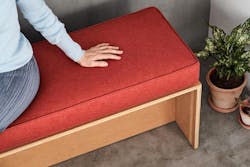Designing a Post-COVID Workplace That Helps Employees Feel Better
Although the near future feels like a giant unknown, the future of work itself is at our fingertips. Imaginations are firing, and there’s frenzied speculation surrounding what the post-COVID-19 office could (and should) look like.
These possibilities stretch beyond what we might consider in office designs, and open floor plans and touchless devices are just the start of the practical innovations that await us. The office of the future is an advanced “wellness environment”—one that’s designed from the ground up to support and nurture its inhabitants.
So, what exactly is a wellness environment, and how has that concept changed throughout COVID-19?
What New Office Wellness Looks Like
Of course, this pandemic has catalyzed our collective obsession with health, and wellness has become a holistic, shifting notion. Take the wellness environments mentioned above: Although this idea seems new and trendy, wellness as a concept actually dates back to ancient practices spanning across both Eastern and Western cultures. And more than just exercise and vegetables, wellness combines mental, physical and spiritual health.
Unsurprisingly, wellness has also become key when it comes to architecture and design. The challenge today is building environments that are both sustainable and sustaining. Designers need to combine art and science not only to suit individuals and teams, but also to keep their creations earth-friendly.
In fact, interest in employee wellness was growing even before the pandemic began. Players in the tech industry have led the way, prioritizing workplace satisfaction and healthy perks. They’ve realized that if they’re going to ask for a massive commitment of time and energy, they’re going to have to look after the humans keeping their business afloat. Case in point: Nestled within downtown Seattle is a mini rainforest biosphere used by Amazon employees needing to decompress.
[Related: Short- and Mid-Term Solutions for Reopening Offices - Part 1]
In return, companies that invest in employee wellness are seeing a multifaceted return on that investment. It’s hard to quantify factors such as motivation, calm, and productivity—but it is paying off. And now, all kinds of companies are spotting the opportunity of this strange year to revolutionize their spaces for wellness.
How Designers Can Incorporate Wellness into Workplaces
Fostering a wellness environment in the workplace can require careful balance, but it doesn’t have to be prohibitive or expensive. In the search for a wellness environment that suits your team, here are three tips that shouldn’t be overlooked.
1. Prioritize ergonomics and active design. Ergonomics are design pieces and elements that support healthy bodies and functions. They form to fit individuals as they work—motivating good posture, promoting active work and preventing strain, injury and stress. Many offices, for instance, have integrated living walls—or vertical gardens—that freshen up recycled office air and help keep employees grounded throughout their days.
In the same vein, active furniture can go one step further and encourage employees to move more. We understand that sedentary lifestyles deplete well-being, and simply introducing more movement into the day can help increase productivity.
2. Spoil employees with fabrics. Textiles are incredibly important for making a space feel good. Your carpets, curtains, coverings and upholstery literally surround you, and they can be instrumental in creating energy that flows back into your body and optimizes productivity.
Today, fabric choice goes way beyond color and pattern. Choose a textile that works actively with people’s movement and mood while also being sustainable. For instance, the chair you sit on at work may quite literally improve your health and wellness, as advances in responsive textile technology mean these fabrics can react to your body’s signals. This is done using bioceramic or infrared technology that can help soothe, support or provide whatever type of perk you need at the moment.
There are also useful smart fabrics available for integration that traditionally include circuitry or a computer.
3. Choose soothing, neutral colors. Many businesses like to flaunt bold colors in hopes that they’ll stand out from the competition. But when we look at effective, healthy workplaces, it’s actually calming colors that are most beneficial. Paint company PPG selects a color to highlight annually, and the organization’s current “palette of the year” is an especially soothing one meant to enhance intention and mindful thinking. In PPG’s eyes, neutral, natural tones complemented by a fresh note of aqua are the winners in helping people feel both grounded and refreshed.
The future of work might still be hazy—the crystal ball offering a murky snowscape—but there’s never been a better time to focus on designing a space that supports, soothes and reenergizes. It’s what we all need right now: to be in a place that feels good and safe.
About the Author: Seth Casden is the CEO and co-founder of Hologenix, a materials science company dedicated to developing products that amplify human potential.
Read next: The Office of the Future is Resilient
About the Author

firstName lastName
i+s partners with design practitioners and other industry experts to deliver informative and engaging content on a variety of topics related to commercial interior design, from the latest trends, research and technology to innovative projects, products and educational CEUs. Interested in becoming a contributor? Contact us today!
